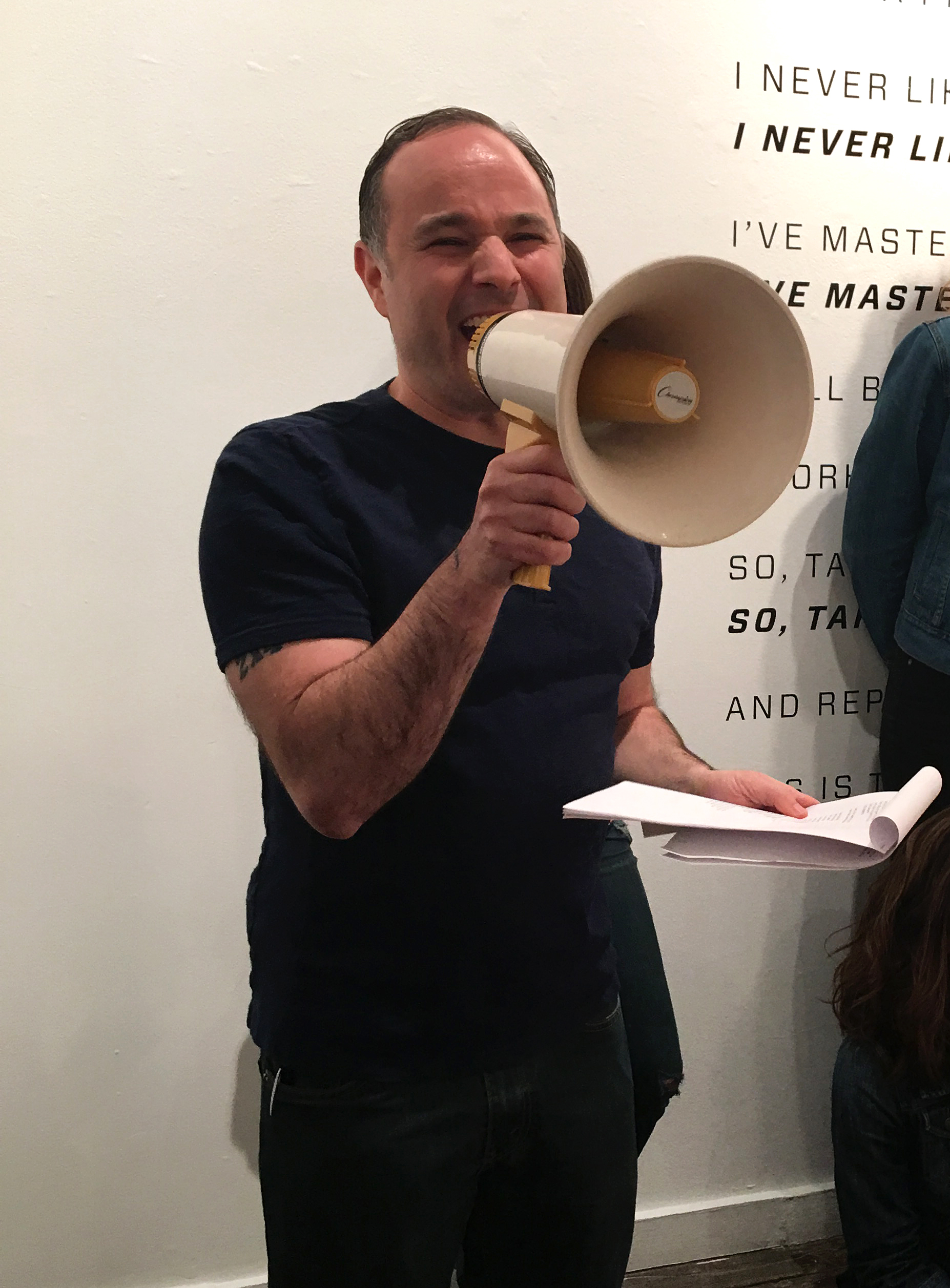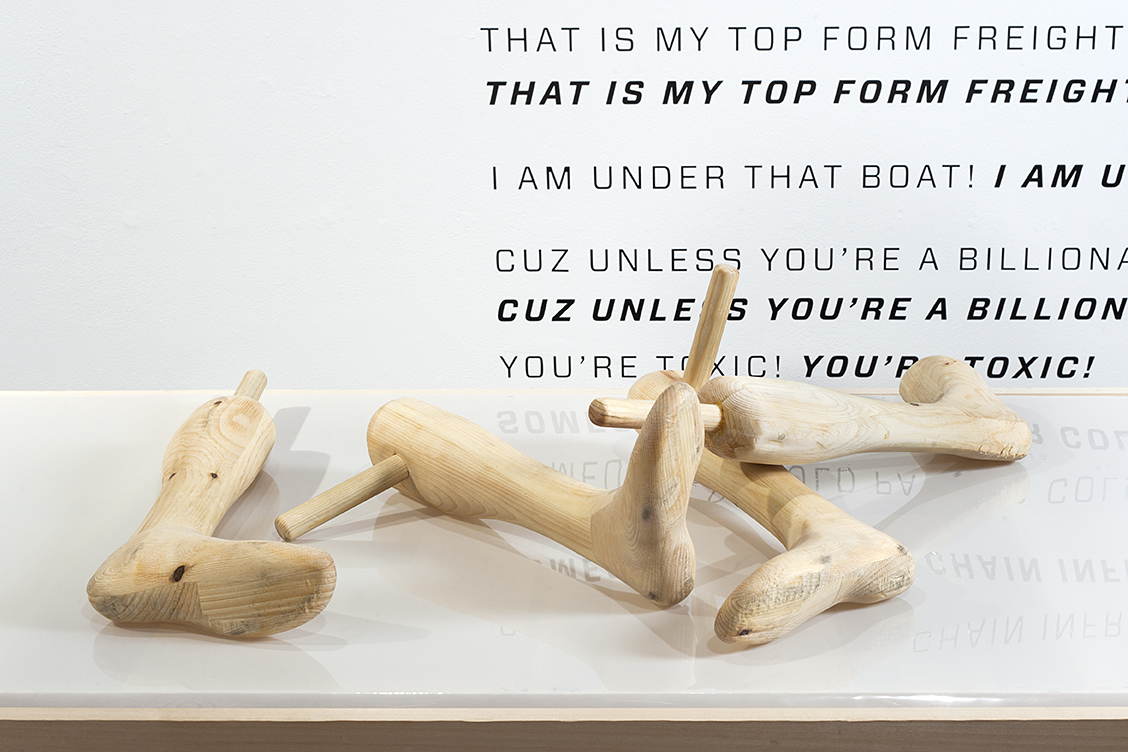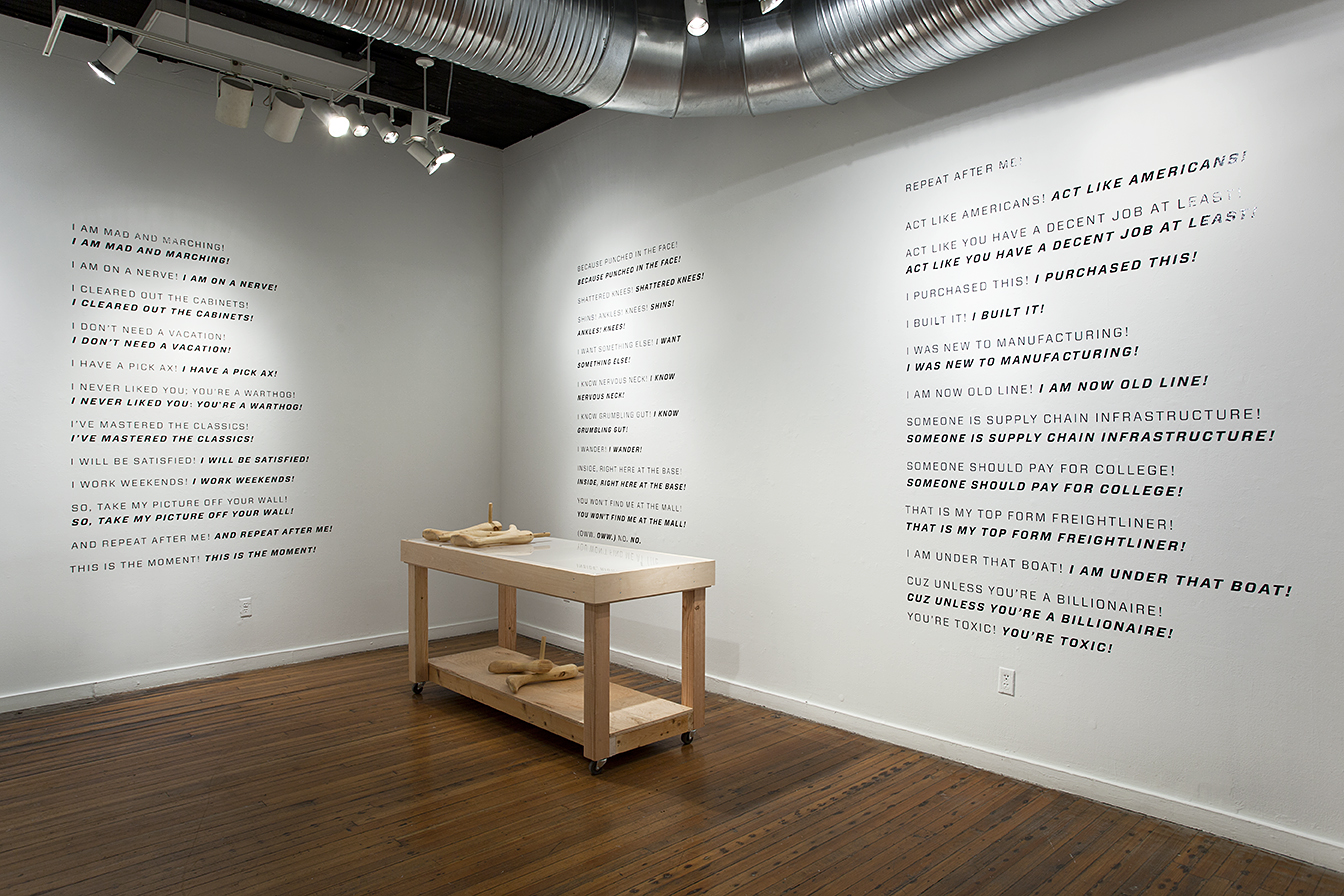 Installation view of This table is a drum/These feet are drumsticks/And I’m sick of it by Marcus Civin. Photography by Kim Llerena.
Installation view of This table is a drum/These feet are drumsticks/And I’m sick of it by Marcus Civin. Photography by Kim Llerena.
School 33 Art Center Presents:
Shape Shifters: Performative Constructions By Renee Rendine, Marcus Civin, and Bobby English Jr.
Curated by Melissa Webb
What follows is a dialogue between artist Marcus Civin and curator Melissa Webb. Marcus Civin’s performance installation, This table is a drum/These feet are drumsticks/And I’m sick of it will be on view at School 33 until June 18, 2016, as a part of Shape Shifters: Performative Constructions.
Civin will perform Saturday, May 14 at 1:00 pm and Saturday, June 11, at 12:00 noon. The June 11 event will feature performances by Civin and Bobby English Jr., and a panel discussion featuring Laure Drogoul, Alessandra Torres, Leslie Rogers, and Hoesy Corona and Ada Pinkston of Labbodies performance art laboratory, as well as the artists and curator of Shape Shifters.
Melissa Webb
So Marcus, when I asked you to be a part of Shape Shifters I was just getting to know you and your work. You were thinking about exhibiting your performance and object-based works in Baltimore, and your past work and ideas for future performances really gelled with the concepts I have been exploring with this show.
Can you talk about your relationship with objects as a performer?
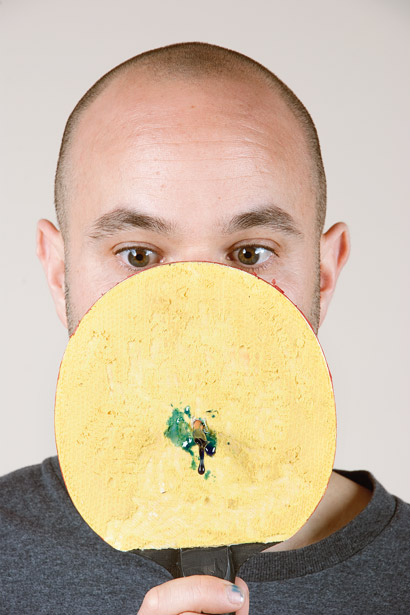 Marcus Civin- American Rifle. Photography by Renee Martin.
Marcus Civin- American Rifle. Photography by Renee Martin.
Marcus Civin
Finding objects, tinkering with objects, breaking objects, remaking objects using new materials, making them different from the way I found them, that’s all part of how I think through my experience. Part of how I rehearse as a performer is by making sculptures and drawings of sculptures. I really love Charlie Chaplin and Buster Keaton. I aspire to a relationship with objects like the ones they had. With them, it’s not just about a performer, right? It’s somebody in a situation with stuff. I think the same is true of Wile E. Coyote and The Road Runner, or Mr. Bean; life in the world becomes a compromise, a negotiation with objects, or a deliberate and sometimes hilarious or disastrous misunderstanding of objects!
Melissa, can you say more about how you chose us as the three artists in Shape Shifters, and explain some of the ideas behind the exhibition?
MW
I became the Exhibitions Manager at School 33 in October of 2014. A lot was already on the schedule before I came along, so I am really just beginning to express myself within this position. For my first curated show I wanted to focus on artists and themes that are really important to me, that say a lot about me and help me to work through things I have been considering as part of my personal and professional research for a long time. My process of making art is quite intuitive, and also I have worked collaboratively with many artists—I also curate in these ways. In my practice as an artist, I have done a lot of large-scale installation and performance works that were first executed outdoors, and then moved into galleries for lengths of time. This has required me to create a new context for them within the space of the gallery, and to find a way for this work to stand on its own during the run of an exhibition, without me or other performers present. This has been a real challenge—sometimes it has involved costumes on mannequins, sometimes photography, sometimes video… For this show I wanted to explore, with each of the artists, ways to engage viewers regardless of whether they saw the live performance aspect, or if they came to the gallery to see the installations—To do what we could to avoid the necessity of the usual context-creating accompaniments. I made a rule—No photos, no videos, no costumes on hangers or mannequins or dress forms, no objects on pedestals with labels explaining their original use…
I chose artists that excite me first of all, artists who work within this format of incorporating objects and environments into their performances, or incorporating performance into their sculptural and/or installation works, however they consider it, and also artists who were capable of meeting the challenge I set forth with this show—to make work that has a life with or without their presence as performer. I also wanted each artist to come from a different angle, from different performance formats and visual languages to meet this challenge.
You, Renee, and Bobby each have such a different way of working and of relating these processes to your lives. Within her performances, Renee harnesses the qualities of an animal or an insect, almost hive-mind instinctual. Her process of making is similar, lots of meditative repetition. Bobby is more reactive with his work, very much about the energy of the body, ceremony, spirituality… and he is very much in the moment when it comes to harnessing the physical energies of a space. Your work is a deliberate reference to protest and the need to shout and to march and you are sharing that—you are encouraging the drummers you are working with, as well as your audience to explore this for themselves.
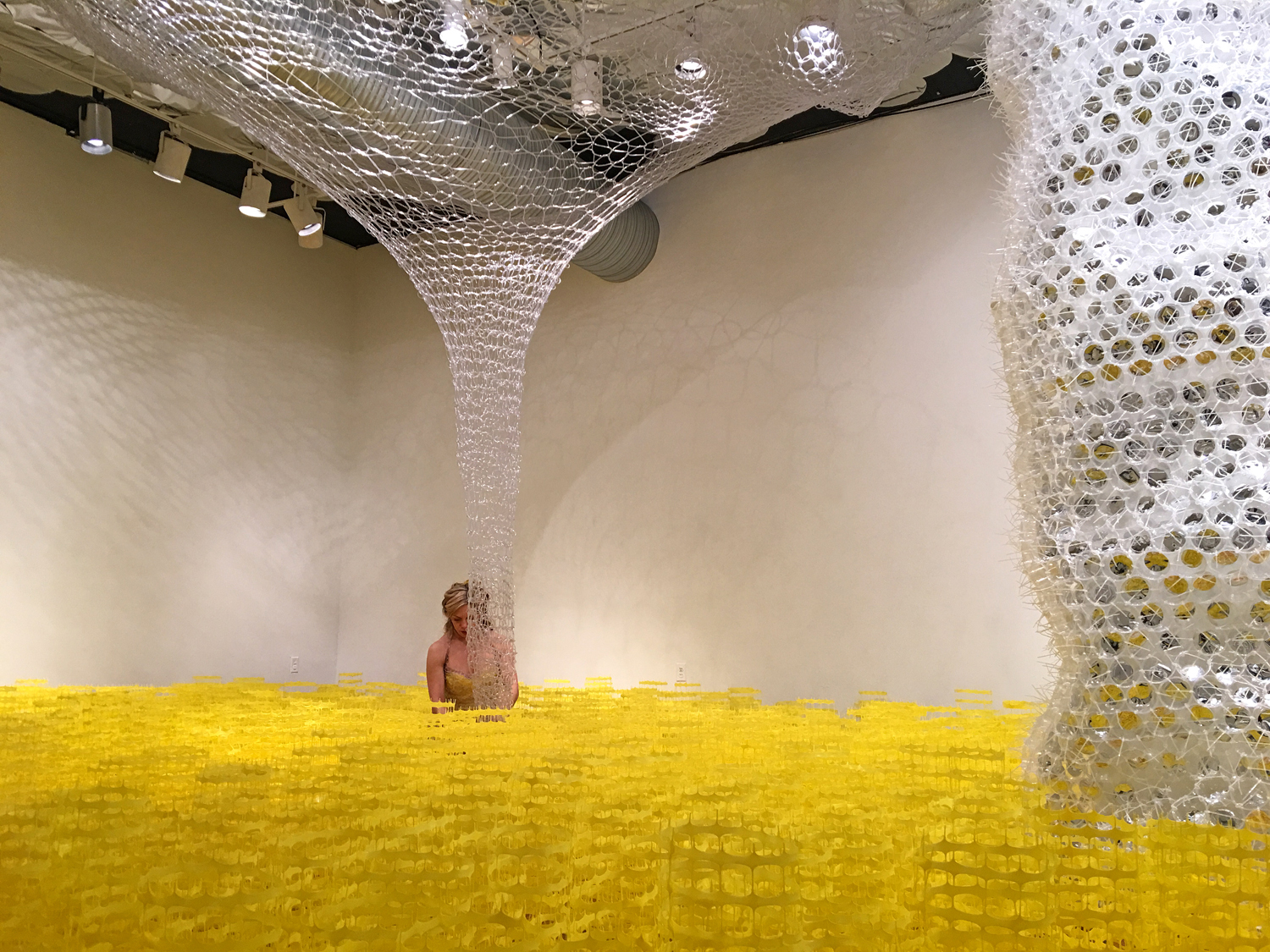 Renee Rendine performs murmuration, as part of the opening event for Shape Shifters: Performative Constructions. Image courtesy of School 33.
Renee Rendine performs murmuration, as part of the opening event for Shape Shifters: Performative Constructions. Image courtesy of School 33.
Renee was a no-brainer to be a part of Shape Shifters, as I am a huge fan of her work and have a long history with her. We both studied Fiber at MICA with Annet Couwenberg, and I have had her speak about her work to my performance students there each year. I have long been in awe of her ability to completely transform a space in the most beautiful, detail-oriented ways, and to put herself entirely inside of that space—to change the space from within. To put her in a show meant that I would be seeing a new Renee Rendine piece soon, and perhaps selfishly I wanted to facilitate that. With Bobby, I have seen several of his performances around town have been completely captivated by them. His use of sculptures as performative objects, the importance of these objects in the stories he tells, and the energies he infuses into them while performing—the aftermath—what I like to call the “beautiful mess” he leaves behind. These things fit in so well with where I wanted to go with this exhibition. And then there’s you…
MC
It took us a little while to get around to a studio visit—we have since referred to this visit as ‘The Best Studio Visit Ever.’ We performed together. We ate cheese. We launched what has become a yearlong conversation about art, performance, and politics.
MW
Yes! You have a neat and tidy apartment at City Arts that also serves as a studio, and as we went along you kept pulling drawings and props out of crevasses—closets, out from under tables, from every kind of box…
MC
This show and our discussions together are important to me. I see our work together in part as an opportunity to think through different modes of performance. There was a point in my performance life where I was like, you know, performance has to be this, and it has to be that. When I was finishing graduate school in Irvine, south of Los Angeles, there would be performances in Los Angeles that I felt would happen too much off in a corner during an event. There would be a bar, there would be music, there would be people seeing each other after a long week, and there would be some sort of filthy performance happening in a corner. (Laughter.) And I say ‘filthy’ in the most complimentary way. I love that work, and I love those artists, but I really hated seeing it compete with the bar, with friends saying hello to each other after a long week. A big part of what I did with every gallery I worked with after that was: ‘You gotta build me a stage.’ I have a whole history of getting galleries to build stages.
MW
You tried to get me to build you a stage for this show! And I was like, no way! No stages! (Yes, more rules) But then I sort of ended up building one for Bobby…
MC
(Laughs.) Yeah, we talked about it. I think since LA I’ve figured out how to belt people into their seats no matter what, and how to handle hecklers and even some animosity. I think now with what we have at School 33, you could have five bars going, and 300 people seeing each other after a long week and we’re still gonna drown them out because we have a megaphone, we have the very large drum, and we have three drummers. We’re OK! We will beat distraction!
MW
Something that has been a really interesting exploration within the live performance aspect of this exhibition is how the three different performances drive the attention of the audience as they overlap in space and time. Renee is absolutely continuous throughout the duration, and does her thing in a very quiet, yet determined way. You can look at it for a while and get lost in it, and then you can look away—It’s still going to be happening. It’s a sort of window into another world. Bobby makes serious demands of the audience’s attention with his movements and vocalization at times, yet at other times he maintains a stillness that serves, in effect, as a moment of resetting for him and for his audience. Marcus, you are the performer in Shape Shifters who is really harnessing the theatrical moment. You are demanding the full attention of the audience for a shorter period of time.
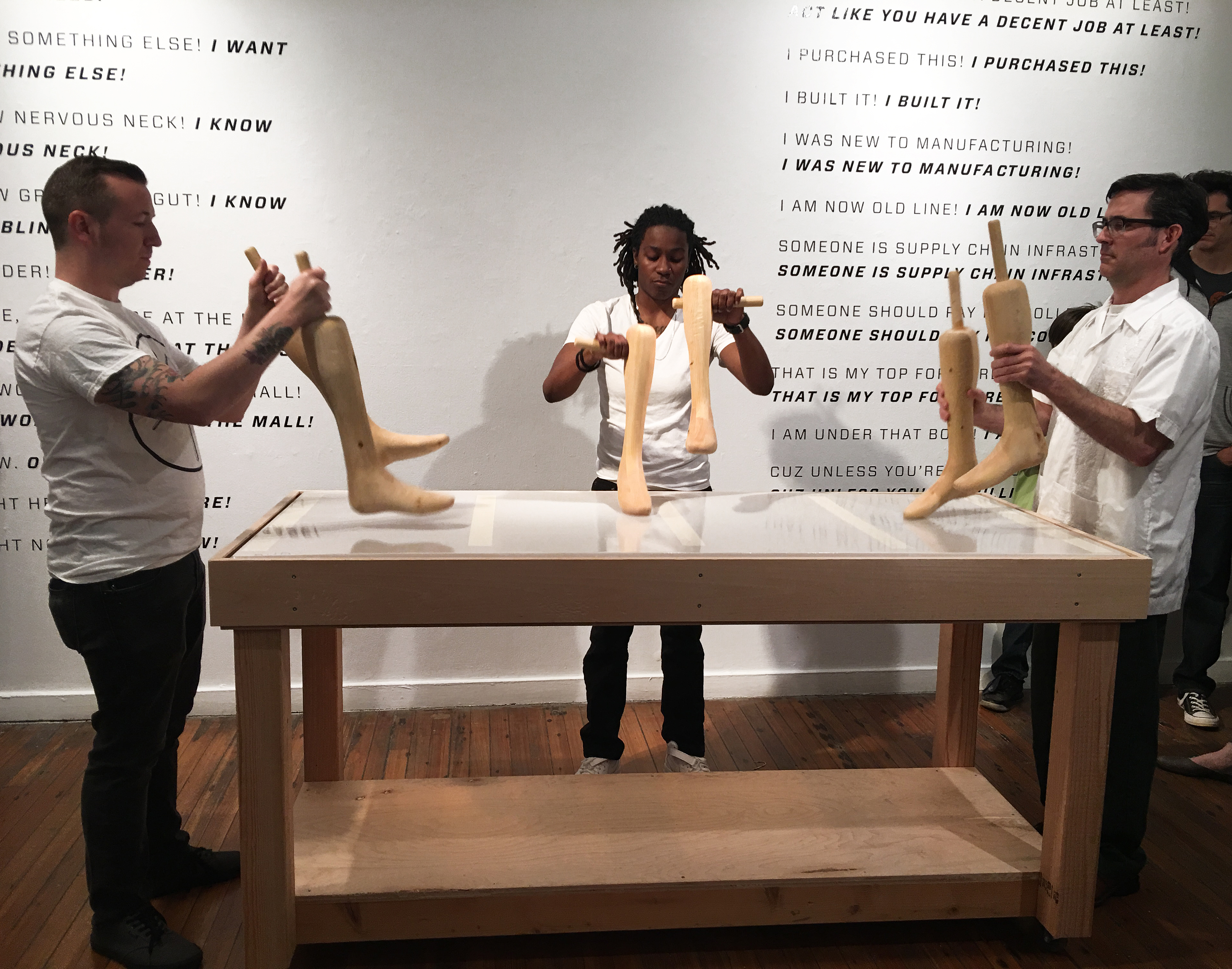 Terence Hannum, Sierra Gaither, and John Lemonds perform as part of Marcus Civin’s piece at the Shape Shifters opening event. Image courtesy of School 33.
Terence Hannum, Sierra Gaither, and John Lemonds perform as part of Marcus Civin’s piece at the Shape Shifters opening event. Image courtesy of School 33.
MC
There is a ‘liveness’ that is precious to me, and for me it comes best in discrete quantities. So this performance at School 33 is not process-oriented. It has a beginning and an end. It’s how it is. It is what it is.
MW
But then the audience has the chance to participate throughout the exhibition when you and the drummers are not performing—they get to ‘take the reins’ if you will.
In addition to your performance work, and your position as an Associate Dean at Maryland Institute College of Art, you write for various art publications. You utilize language in your performances and physical works of art as well. Do you see a connection between your professional writing and the writing related to your performances?
MC
Yes. I’ve been fortunate in my critical writing that I have been encouraged to write about artwork that I am interested in. My hope is that my writing stands next to the artwork I am writing about and exists in relationship to that work and other work that I admire. Much of the work I admire is also work I am thinking about in relationship to performance and in relationship to sculptural objects. At MICA, I’m writing all the time too—about new courses, the accomplishments of students, and the vision of the college. I’m lucky in this work to be around amazing students and artists and designers. MICA is a space where people are trying out ideas all the time. You know, some weeks at MICA I feel like I see more art than almost anybody in the world, and so while my job is often administrative in many ways, I feel I am always building a house for art. That means a lot to me. All of my work is related. Spending the day in the museum or spending the day in the office or spending the day in the studio, it feels like the same thing to me because I’m concerned with the interrelationship of art and ideas, of seemingly irreconcilable objects. For me, the good design of a school, of a program, the good design of a poster, the choreography of a performance… they are all fascinating and fascinating similarly for me.
If I’m writing an art review, I’ll often take pages of notes in the process of trying to understand an artist. I’ll turn to a poet or a short story that seems somehow connected. That reading and note taking is like a sketch for the writing and, at the same time, for my performances too. Getting inside another artist to write about them, or getting inside of a student’s practice with them, to try to be next to them with their work, to understand, from behind their eyes where they’re trying to get—that’s been really useful in my ongoing work to try to be honest and precise with myself and also to try and step outside myself.
Melissa, can you say more about what performance has meant to you in your work?
MW
There are a lot of potential answers to this, but one pretty important thing is that in my life, being a performer has helped me to be a more self-realized, confident person. It has been a right-of-passage for me, in the same way that being a teacher has been—I connect the two all of the time. Performing live for an audience, or standing in front of a classroom full of students looking to you, you have to be self-assured and concise, no matter what else you do. If mistakes happen you have to own them, you can’t walk off, you can’t have a redo. This need to exercise decisiveness, and to think on my feet has given me a lot of confidence. Whenever I am in a situation where I am performing, or practicing for a performance, developing it, and trying it in different ways, it is always such an incredible learning experience for me—a look into myself in the moment.
I consider my current primary medium to be installation, which sometimes involves performance and sometimes does not, but I have spent time operating on the opposite site of that as well—a good amount of the performance work that I engaged in in my twenties was about the body—without a lot of stuff. I worked with a collaborative performance group called aminibigcircus for twelve years doing movement and gesture-based performance. I brought a lot of visual elements to our work, as I came from a sculpture and fiber background. (The others in the group came from theatre acting backgrounds.) We utilized visual elements in our film work, and in our larger scale theatrical productions in the form of sets and costumes, but generally in our live performances our garments were neutral in color and quite basic, which was often to my dismay! (Laughter.) I guess I have worked a lot of different angles with respect to the way a body can relate to space—It can be really simple or it can be really elaborate. When left to my own devices, performance as it relates to the body has been not only about movement, but about the impact of garment upon movement. My solo performance work incorporates costume, often changing or exaggerating the silhouette of the body. These things are also the focus of the performance course, Expanded Body: Performance and Environment, that I teach in Fiber Department at MICA.
MC
Do you want to talk about Rooms Play?
MW
Yes! When I was talking earlier about performance as a right of passage and the ways that performing can relate to one’s life as an individual, I think of this experience as a stand out moment—participating in the Copycat Theatre’s Room’s Play as part of The Transmodern Festival in 2011. Rooms Play encompassed the space of the Whole Gallery in the H&H building as well as all of the Current Gallery down the street. Myself and about forty other artists built immersive environments and performed in them for audiences traveling through these spaces.
MC
I was a part of one of these audience tours. That was one of the first artworks I saw when I came back to Baltimore after being away for fifteen years. I was enthralled, thrilled to be learning about this very different kind of performance in a context that was unfamiliar to me at the time…
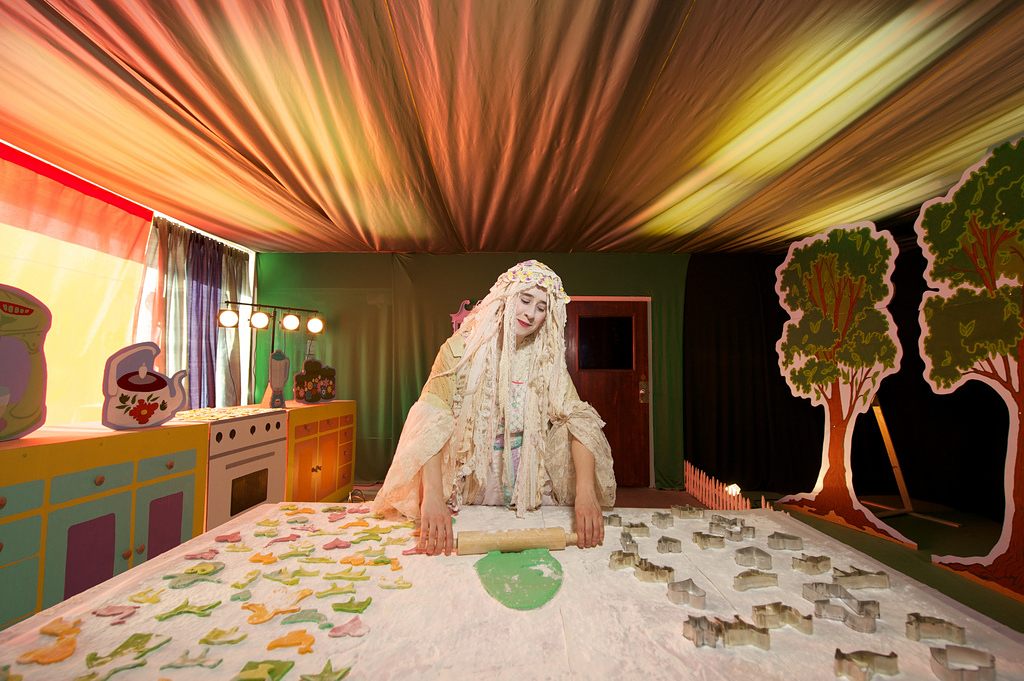 Melissa Webb performs The Magic Flight, in Copycat Theatre’s Rooms Play as part of the 2011 Transmodern Festival. Photography by Theresa Keil.
Melissa Webb performs The Magic Flight, in Copycat Theatre’s Rooms Play as part of the 2011 Transmodern Festival. Photography by Theresa Keil.
MW
I have actually heard that story before—someone coming to Baltimore for the first time, or after a long time, and ending up at Rooms Play, mind completely blown. The first year of Rooms Play, one of the members of Copycat Theatre was taking my class at MICA so I went—they couldn’t get me to leave at the end. I just knew I wanted to be involved when they announced they would be doing a second year. Each of us had three minutes with each group of 3-4 people, and then three minutes to reset before the next group came into our rooms… for hours on end! Being in that environment, for so long, forming these micro-relationships with the audience and having them participate in what I was doing without hesitation… repeating the performance over and over, gave me this time to fully immerse. I really became that character. I became the old cookie-baking grandma in that room. This really speaks to the way I see performance for myself—that it is an experience not just for the viewer but also for the performer. At least that’s what I want. When I am performing a piece I want it to be just as amazing for me and for my fellow performers as it is for the audience.
MC
I don’t know if I’m that transported. Maybe sometimes… When I lived in San Francisco after college, I was neighbors with an artist named Guillermo Gomez-Pena. He knows how to get people to want to join in during his performances. At his request, audience members at the performances I attended did these really intense things sometimes, often dealing with racial and cultural stereotypes. I observed how Gomez-Pena would get people’s trust. He would walk right up to them in the audience, take them by the hands, have them stand up, walk to the stage with him, and he would gaze right into their eyes, maybe a hand now and then on their shoulder… In this way, I think he would be getting a sense of that person, figuring out what degree of interaction that audience member was comfortable with. Once he established that comfort level, they could do things together like writing out stereotypical racial terms in Sharpie on their bare chests.
Over the last five years that I have been in Baltimore, I have performed in New York, Miami, Los Angeles, Washington, DC. … I’ve been experimenting with gaining an audience’s trust. You know, you look at someone once, and they look away. Forget that person as a daring participant. If they meet your gaze once, then meet your gaze a moment or two later, you’ve got someone you might be able to perform with.
MW
Yes absolutely. Tell me about the evolution of your call-and-response work.
Baltimore Call and Response by Marcus Civin.
MC
At first, I was employing call-and-response as a teaching tool. I was bringing a megaphone to class with me with my attendance sheet. I wanted my students to hear their voices amplified. When I was invited to speak in other people’s classes, call-and-response was a way to collect the themes that were going on in these classes and to introduce myself. In a lot of cases I would use the call-and-response to have fun with the ideas and the language from the readings on the syllabus and to try to establish some common ground with a new group of students. I also wanted the students to have an experience of protest in the classroom, to give them an opportunity to cause a ruckus. After all, the histories of avant-garde movements that are taught in arts schools and art departments are largely political. I often think about Mario Savio and the Free Speech Movement, the famous and impassioned speech he delivered in Berkeley…
After Freddie Gray died in police custody, like a lot of people, I was angry. A few weeks after the Baltimore Uprising began, I was doing a performance in a quasi-public space in New York, and more than half of the people there didn’t want me there; they didn’t know I was coming, and they didn’t like the noise, the loud call-and-response. So, I had hecklers and people telling me to fuck myself and trying to pull out the cord on the sound and stuff like that. The confluence of those two completely unrelated events helped me to realize that the call-and-response work was angry—angrier than I thought it was in my conscious mind. In the middle of that New York performance, a different voice came out of me to deliver the words I had been writing already for a few years; it was a really different mode of address than I had previously been using in the classroom. Perhaps this work I’m bringing now to School 33 was a Baltimore piece from the beginning.
Melissa, what do you think are some positives about doing performance work here in Baltimore?
MW
As you know there is a very rich performance community in Baltimore in terms of experimenting—utilizing the scene in this way and supporting one another. With venues such as Laure Drogoul’s 14 Karat Cabaret, Lighthole Gallery, Psychic Readings, EMP’s Pulse events, Labbodies’ performance laboratory… and so much more I am haven’t mentioned here. It has been a scene that encourages experimentation, an incubator if you will. I’ve watched performers try a piece several times until they work through it, and there is a wonderful kind of patience and encouragement of this within the audiences here.
MC
There’s also this vibrant slam poetry scene, club scenes, the Vogue ball scene, hip-hop videos shooting every weekend it seems. And, D. Watkins encourages us to think about dirt bike street racing as an art form. There’s more probably that I’m not thinking of right now. There is a performativity to Baltimore in general.
MW
You grew up in Baltimore but you moved away for undergraduate and graduate school, and lived in other cities before returning to Baltimore. Tell us about performance communities you have been involved in either in school or otherwise.
MC
The pasts I’ve imagined are more interesting than the ones I’ve lived! But, I am indebted to my teachers and mentors. kari edwards was another neighbor of mine in San Francisco, and she got me involved in these salons where every great living poet came through to perform or sit in a circle and listen to prolonged arguments about topics from writing to imperialism, gender to self-publishing. I studied with Yvonne Rainer at University of California, Irvine, who taught me about radical juxtaposition and coaxed out of me the realization that humor and political outrage are not mutually exclusive. Yvonne, Simon Leung, Mara Lonner and Daniel Joseph Martinez taught me to take my time in performance, that a performer’s genuine carefully articulated fascination can become the audience’s fascination… In Los Angeles, around 2009, I thought everyone was talking about performance, but I didn’t feel it was too much in evidence among my peers, so I co-organized a huge performance festival. Chinatown in Los Angeles is a walking district and at that time there were all these small galleries in that area that I was excited about. Much like Kimi Hanauer has done with the Alloverstreet Art Walk in Baltimore, I walked around and asked every gallery if they would host a performance on the same night. If they couldn’t think of anyone to invite, I invited someone for them. I performed too. I think we created a lot of unique contexts for new performance. And, because it was LA, by the second year I did it, Natalie Portman showed up!
I’ve always wanted to recreate this Martin Kersels performance I saw around that time at the Orange County Museum of Art (2008, I think), but I haven’t had the guts to ask if I can. Kersels is a famously big man. In this performance, he lay on a small stool, on his stomach, and chopped at a stool leg with an ax until the stool collapsed and he collapsed on top of the wreckage. He explained exactly what he was going to do before he did it, and then he did it. That was the whole piece. This had an influence on me. It was simple, unpretentious, suspenseful, dangerous, and ridiculous.
MW
Please talk a little about your process of building This table is a drum/These feet are drumsticks/And I’m sick of it, your piece for Shape Shifters.
MC
I started working to fabricate the objects for Shape Shifters in January. I had an idea of these legs. I had been drawing antique boot forms that shoe stores used to use to keep the shape of leather boots. I had this crazy idea that I wanted to create a show of disembodied marching feet. Working with call-and-response, I was starting to feel like my approach was too cerebral, too academic. I wanted to get back to what it means to put your body in the way, to stand in harm’s way to protest, to hold a line, literally to take a stand. You said: ‘You should really talk to Lewis Colburn, from Philadelphia, who will be exhibiting upstairs at School 33 at the same time you are.’
You were right. Lewis is amazing. He made the leg forms I was imagining, and we are using them in the performance as giant drumsticks on a giant drum that the impeccable Kyle Lanning Smith fashioned perfectly. Similarly, working with the designer Katrina Keene on the vinyl wall texts, a typography and visual syntax has evolved easily and organically. For the performance, I hired three drummers and we scored a performance together that will be more or less similar each time we do it. I am delighted by what we have come up with together—Sierra Gaither, Terence Hannum, John Lemonds… They are brilliant. I think we have made something whimsical and serious and fun to watch.
The connection with Bobby English Jr. has also been meaningful for me. Artforum approached me to do a piece of writing about the reaction of the art community to the Baltimore Uprising. I was nervous about it because I thought I was too institutionally oriented, too white, too old, too comfortable to do that writing. But I did it. The approach I took was to talk to as many people as I could about what should be in the article, and who I should feature. When I talked to you, one of the things you said right away without hesitation was: ‘You gotta talk to Bobby.’ For that article, Bobby became central to describing how artists have reacted to the Uprising—in particular how Black artists have been making work with renewed fervor about identity, humanity, physicality, and racial justice in Baltimore. It wasn’t even weeks later that you said, ‘Bobby is gonna be in the show.’ We never really talked about if this was all related, but for me, in terms of what this last year has been like in Baltimore, it was very connected.
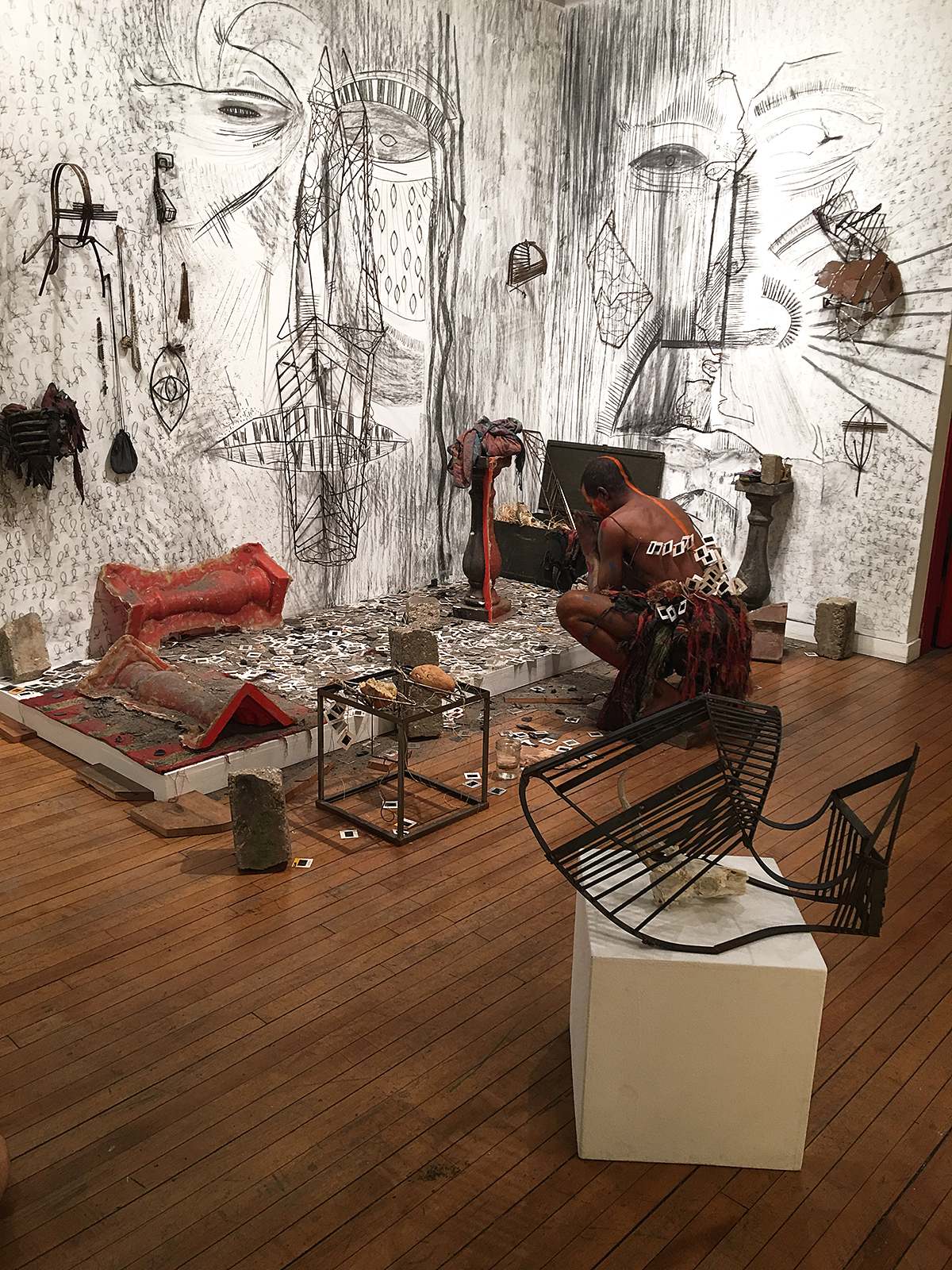 Bobby English Jr. performs The Eye and I at the opening event for Shape Shifters: Performative Constructions. Image Courtesy of School 33.
Bobby English Jr. performs The Eye and I at the opening event for Shape Shifters: Performative Constructions. Image Courtesy of School 33.
MW
Wow, that’s really amazing. I hadn’t thought about that. I have gotten so much out of curating this exhibition, in a way that I think will feed both my art, and also my teaching practice well down the road. For me, teaching and curating—as well as facilitating in the way that I do at School 33, are very similar, especially because of School 33’s role as a place that has been there, for over 35 years, to help artists realize their artistic goals, helping them accomplish things they wouldn’t normally have the support in doing…
MC
Something that is important to me about School 33 is its place within what I think of as the Alternative Space Movement. In the US, and the art world more generally, alternative space has helped audiences get to know living artists. The dominance of the idea that artists should determine the agenda in the arts, and the phenomenon of artists making an artwork and then having it out of the studio and into the gallery the next week… that idea and that phenomenon have been supported by an Alternative Space Movement. School 33 and spaces like it came into being as spaces where artists could rule. At least the way I understand that history, it travelled in tandem with a lot of artists also saying: ‘I want to bring my lived experience into the gallery by performing in the gallery’. It is meaningful to me that we are here having a performance show at School 33, a long-established alternative space. We stand on the shoulders, I feel, of a history of artists helping audiences get excited about having bodies in their art shows. Now, in Baltimore, we have living artists producing art with a sense of urgency, and live artists in the room as part of what audiences are experiencing centrally—and vitally—as visual art. I like that.
To see more of Marcus Civin’s work, please visit http://marcuscivin.com/
Melissa Webb’s past performance works can be viewed at www.melissawebbart.com
To learn more about Shape Shifters: Performative Constructions, and School 33 Art Center, please visit www.school33.org.

